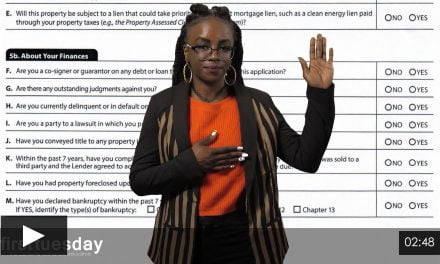This article critiques the Federal Housing Finance Agency’s decision not to recommend principal reductions for negative equity mortgages held by Fannie Mae and Freddie Mac.
Too expensive for today’s taxpayer?
Although late by even Congressional standards, the Federal Housing Finance Agency (FHFA) has finally returned with a decision on their recent proposal for Fannie Mae and Freddie Mac (collectively dubbed Frannie) to begin offering principal reductions (cramdowns) to underwater homeowners. [Click here for the full FHFA report.]
Citing a threat to Frannie’s liquidity, the leaderless FHFA (read: congressional interference in appointments) concludes that cramdowns are not Frannie’s best loss mitigation tool. Thus, the federal government has decided against allowing Frannie to offer cramdowns. [For a report on the beginnings of the cramdown proposal, see the November 2011 first tuesday article, Cogitating cramdowns: a tale of suspense.]
The FHFA estimates that it would cost the Treasury nearly $100 billion to fund the capitalization needed to facilitate Frannie’s discharge of the negative equity associated with all of the mortgages in their portfolio. The benefits of instituting a cramdown program do not justify the cost to those in the U.S. who pay income taxes, according to FHFA Acting Director, Edward J. DeMarco.
Lower monthly payments either way
The FHFA acknowledges their mandate to offer the maximum assistance possible to distressed homeowners. Further, they concede that principal reductions would provide much needed relief to negative equity homeowners. However, they maintain that current loss mitigation tools in use allow them to fulfill their laudable mission without resorting to principal reductions to eliminate negative equity situations.
Among their current arsenal of Frannie-salvaging mortgage loss mitigation tools, the FHFA insists that modification programs which offer interest only or negative amortization payments (without any reduction in the rate of interest earned by Frannie, no refinancing please) result in the same amount of monthly payment reduction for underwater homeowners. The negative amortization modifications are achieved without risking Frannie’s tenuous grasp on liquidity (the reason they were brought under conservatorship in the first place).
Thus, Frannie-instituted cramdowns will remain a distant dream for underwater homeowners barring the unlikely event of a congressional mandate in favor of the debtor class.
Negative amortization a cramdown is not
The FHFA’s rhetoric is dangerously persuasive. At first glance, it seems a sound fiscal decision to refrain from offering cramdowns since current mortgage modification programs achieve the “same ends” for the homeowner at a lower cost to the taxpayer. The reasoning is that as monthly mortgage payments decrease, disposable income is liberated from the lender’s monthly grasp and can be injected back into the economy. This feat provides energy as a boon to gross domestic product (GDP) since most homeowners will spend the extra money rather than save, as our current national savings rate shows. Hence more sales, more production, more jobs, and so on. [For current savings rate data, see the November 2011 first tuesday article, The 20% solution: personal savings rates and homeownership.]
However, FHFA’s assertion that strategies such as their recently announced principal forbearance program (no pay today, but big pay later) achieve the same ends as principal reduction is patently false — a deliberate deception through the alchemy of creative number crunching. Alternatively, a more generous conclusion here might be that the FHFA has simply failed to see the bigger societal damage evolving in the failure of their mandate to stabilize and encourage homeownership. [For more information on the principal forbearance program, see the February 2012 first tuesday article, Frannie forbears, unemployed homeowners defer.]
Granted, it is mathematically correct that principal forbearance programs lower monthly mortgage payments to the same degree that cramdowns would — the FHFA has invested the past three months and who knows how many taxpayer dollars proving as much. It seems a worthwhile endeavor given the ultimate conclusion that GDP will benefit and the taxpayer gets a pass from investing in a costly cramdown policy.
However, principal forbearance programs do absolutely nothing to address the issue of the homeowner’s inability to sell a negative equity home. This lock on home sales in turn stifles the multiple listing service (MLS) market; the underwater homeowner remains banished from the marketplace of replacement and upgrade homes, paralyzed by negative equity but with a few hundred extra dollars a month to spend on iPods and back rubs.
The shortsale dilemma
Shortsales are a tragic alternative to cramdowns. Both affect the lender equally, the reason they dislike and discourage both via endless negotiating games. A shortsale is effectively a cramdown, reluctantly approved by a Frannie lender on the resale of the property. Both scenarios result in the mortgage’s return to a mark-to-market valuation thus making the lender’s loss the same.
The homeowner however, suffers unnecessarily and disproportionately in a shortsale scenario. Ultimately, this dynamic adversely affects the economy as a whole, California’s in particular.
The negative equity home’s shortsale bars the homeowner from purchasing a replacement home since for some mysterious reason a homeowner’s credit must be destroyed by lender dictate in order for the home to be sold at its fair market value (FMV). Had the homeowner been offered a cramdown rather than an extend-and-pretend mortgage modification (which also badly damages one’s credit), he may have sold his home without lender consent — thus avoiding the crippling credit ramifications which only serve to further stultify the housing market and the greater economic recovery.
In the cramdown scenario, impaired credit to borrow and spend is avoided, the lender’s acquisition of another real estate owned property (REO) is circumvented and a home is sold at its true FMV. All these activities add to home sales volume, stabilize market prices and catalyze the process of a virtuous market cycle.
Cramdowns solve foreclosures
Affective foreclosure prevention is the FHFA’s purported goal in all of this debate and decision-making. Ultimately, they miss the mark on this front as well. The refusal to offer principal reductions to negative equity homeowners will serve only to encourage a burgeoning and now openly recognized trend of strategic default in the U.S.
The FHFA itself notes in the extensive study supporting their decision that millions of underwater homeowners are current on their mortgage payments, thus proving their ability to pay. The question remains, however, are they willing?
The answer to this question depends on whether or not the homeowner:
- is an economic tenant in their own home due to negative equity; [See the March 2011 first tuesday article, The negative equity plague: California’s home insolvency crisis.]
- requires the mobility necessary to improve his employment situation; [See the January 2012 first tuesday article, Migratory lockdown: underwater homeowners confined.]
- can tolerate the negative credit effects resulting from strategic default; [See the December 2011 first tuesday article, The FICO farce.]
- plans to file bankruptcy for permanent debt relief;
- has access to a mortgage modification resulting in reduced payments thus deferring delinquency until payments reset; [See the November 2010 first tuesday article, Mortgage modification showdown: interest rate reductions v. principal reductions.] and
- suffers from the moral delusions that often supplant the exercise of his legal right to default and force liquidation by lender foreclosure. [See the July 2011 first tuesday article, Strategic default smarts.]
Homeowners suffering from the negative equity plague are no longer satisfied with the extend-and-pretend mortgage modifications initiated in 2008 to dismal failure due to high re-default rates.
The increasingly better informed (better educated) and more savvy homeowner in this new real estate paradigm understands that a lower monthly payment doesn’t solve the real issue at hand — solvency and the black-hole asset of a negative equity home in which they are imprisoned. [For more on the causes and effects of negative equity, see the February 2011 first tuesday article, The negative equity plague: California’s home insolvency crisis.]
If the FHFA’s only barrier to a cramdown policy is funding, perhaps now is the time for Congress to take the Buffet rule seriously. $100 billion? That revenue could easily be generated if the wealthiest among us began paying the same tax rate as their secretaries on income received (carried interest bonuses) while rendering services to the companies they run.














The other important part of the DBSD rnliug is that “gifting” is no longer permitted in the Second Circuit (i.e. in bankruptcies filed in NY). The court found that “gifting,” a practice by which secured creditors provide a small recovery to equity holders out of the secured creditors’ own recovery to buy equity’s support even though unsecured creditors are not being paid in full, violates the absolute priority rule. This had been a common practice to avoid fighting with old equity and had not previously been thought to violate absolute priority since a gift from secured creditors to equity holders doesnt really affect what unsecured creditors receive. The Second Circuit put a stop to this practice (assumming there is an objection by unsecured creditors), finding that “gifting” violates the language of the Bankruptcy Code and leaves open the potential for misbehavior by equity holders who control the ch. 11 process. It is likely that this decision will lead to more fights with equity holders who can no longer be as easily paid off to go away.